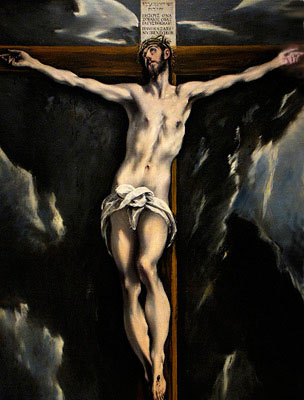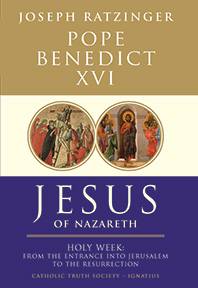In our reflection on Jesus’ prayer on the Mount of Olives in chapter 6, we encountered a further meaning of this same word (teleioun) in connection with Hebrews 5:9: in the Torah it means consecration, bestowal of priestly dignity, in other words, total dedication to God. I think we may detect this same meaning here, on the basis of Jesus’ high-priestly prayer. Jesus has accomplished the act of consecration – the priestly handing-over of himself and the world to God – right to the end (cf. John 17:19). So in this final word, the great mystery of the Cross shines forth. The new cosmic liturgy is accomplished. The Cross of Jesus replaces all other acts of worship as the one true glorification of God, in which God glorifies himself through him in whom he grants us his love, thereby drawing us to himself. The Synoptic Gospels explicitly portray Jesus’ death on the Cross as a cosmic and liturgical event: the sun is darkened, the veil of the Temple is torn in two, the earth quakes, the dead rise again. Even more important than the cosmic sign is an act of faith: the Roman centurion – the commander of the execution squad – in his consternation over all that he sees taking place, acknowledges Jesus as God’s Son: “Truly, this man was the Son of God” (Mark 15:39). At the foot of the Cross, the Church of the Gentiles comes into being. Through the Cross, the Lord gathers people together to form the new community of the worldwide Church. Through the suffering Son, they recognize the true God. While the Romans, as a deterrent, deliberately left victims of crucifixion hanging on the cross after they had died, Jewish law required them to be taken down on the same day (cf. Deuteronomy 21:22-23). Hence the execution squad had to hasten the victims’ death by breaking their legs. This applied also in the case of the crucifixion on Golgotha. The legs of the two “thieves” are broken. But then the soldiers see that Jesus is already dead. So they do not break his legs. Instead, one of them pierces Jesus’ right side – his heart– and “at once there came out blood and water” (John 19:34). It is the hour when the paschal lambs are being slaughtered. It was laid down that no bone of these lambs was to be broken (cf. Exodus 12:46). Jesus appears here as the true Paschal Lamb, pure and whole. So in this passage we may detect a tacit reference to the very beginning of Jesus’ story – to the hour when John the Baptist said: “Behold, the Lamb of God, who takes away the sin of the world!” (John 1:29). Those words, which were inevitably obscure at the time as a mysterious prophecy of things to come, are now a reality. Jesus is the Lamb chosen by God himself. On the Cross he takes upon himself the sins of the world, and he wipes them away. Yet at the same time, there are echoes of Psalm 34, which says: “Many are the afflictions of the righteous, but the LORD delivers him out of them all. He keeps all his bones; not one of them is broken” (Psalm 34:19-20). The Lord, the just man, has suffered much, he has suffered everything, and yet God has kept guard over him: no bone of his has been broken. Blood and water flowed from the pierced heart of Jesus. True to Zechariah’s prophecy, the Church in every century has looked upon this pierced heart and recognized therein the source of the blessings that are symbolized in blood and water. The prophecy prompts a search for a deeper understanding of what really happened there. An initial step toward this understanding can be found in the First Letter of Saint John, which emphatically takes up the theme of the blood and water flowing from Jesus’ side: “This is he who came by water and blood, Jesus Christ, not with the water only but with the water and the blood. And the Spirit is the witness, because the Spirit is the truth. There are three witnesses, the Spirit, the water, and the blood; and these three agree” (1 John 5:6-8). What does the author mean by this insistence that Jesus came not with water only but also with blood? We may assume that he is alluding to a tendency to place all the emphasis on Jesus’ baptism while setting the Cross aside. And this probably also meant that only the word, the doctrine, the message was held to be important, but not “the flesh”, the living body of Christ that bled on the Cross; it probably meant an attempt to create a Christianity of thoughts and ideas, divorced from the reality of the flesh – sacrifice and sacrament. In this double outpouring of blood and water, the Fathers saw an image of the two fundamental sacraments – Eucharist and Baptism – which spring forth from the Lord’s pierced side, from his heart. This is the new outpouring that creates the Church and renews mankind. Moreover, the opened side of the Lord asleep on the Cross prompted the Fathers to point to the creation of Eve from the side of the sleeping Adam, and so in this outpouring of the sacraments they also recognized the birth of the Church: the creation of the new woman from the side of the new Adam. [Excerpt from Jesus
of Nazareth: Holy Week: From the Entrance Into Jerusalem To The Resurrection,
by Pope Benedict XVI, Chapter 8, © 2011 Ignatius
Press (US), CTS
(UK). Used with permission.]
|
. | |||||
|
publishing address: Park Royal Business Centre, 9-17 Park Royal Road, Suite 108, London NW10 7LQ, United Kingdom email: living.bulwark@yahoo.com |
. |

